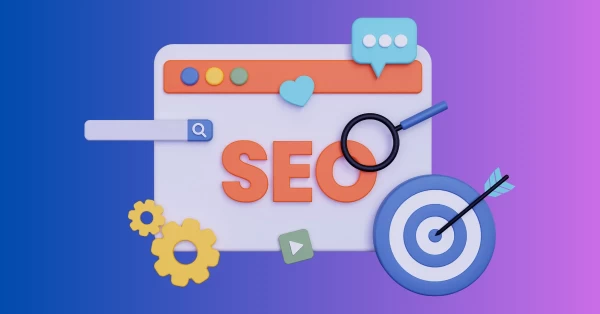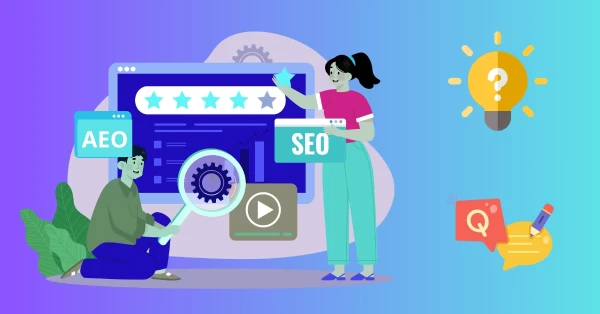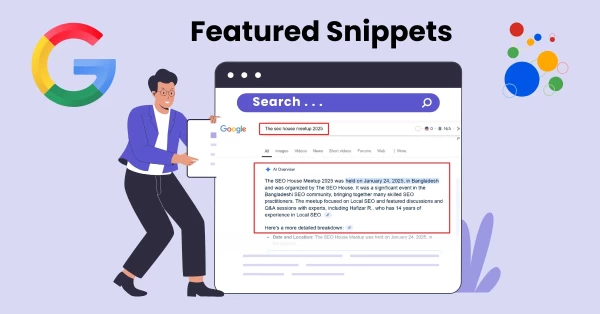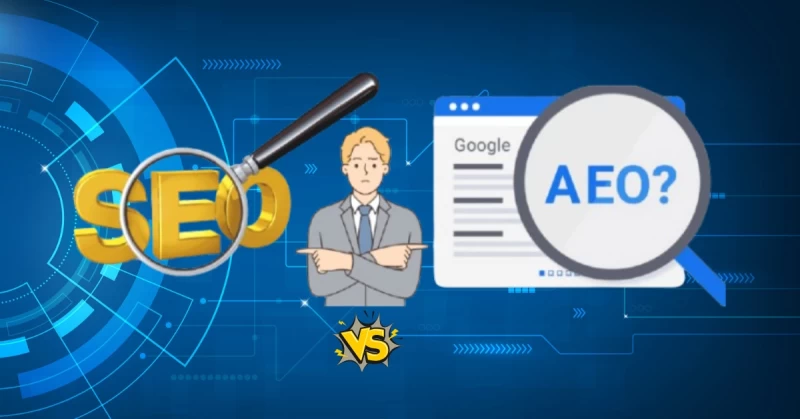Imagine this: In 2025, 6 out of 10 people don’t click on anything after they search on Google. Why? Because they already find what they need—right there on the search page.
That’s because of tools like AI summaries, voice assistants, and featured snippets. This new shift is called Answer Engine Optimization (AEO). It helps people get answers faster, but there’s a problem—it’s making it harder for websites to get clicks.
But hold on—SEO isn’t dead.
Well, SEO has come a long way since the early days of the web. Danny Sullivan, a journalist, probably started the first publication about Search engine marketing in 1997. Many critics referred to him as one of those who popularized the term Search Engine Optimization.
Still now, more than 70% of what people do online still starts with a search engine. So, getting your site to rank high still matters. But now, with AI giving answers right away, businesses have a new challenge:
Should they stick with SEO or switch to AEO?
In this blog, we’ll explain:
- Why SEO is still important, but needs smarter tactics.
- Why AEO is growing fast.
- How to use both together to stay ahead in 2025.
Let's start!
What Exactly is SEO in 2025?

SEO (Search Engine Optimization) in 2025 isn’t what it used to be. A few years ago, people could rank their websites by using tricks—like keyword stuffing or buying spammy backlinks. But those days are gone.
I recently asked my colleague Mr. Sabit, an SEO expert at Upspell, on how Professional SEO Services Provider SEO works now. He said one thing very clearly: authenticity matters more than ever.
Search engines, especially Google, have become smarter. They don’t just look at keywords anymore. They want real, helpful, and unique content. Yes, Google still shows AI-generated content—but only if it actually helps users. If it’s just fluff, it won’t work.
One big change? Backlinks. In the past, people used to get links from any site—even low-quality or shady ones. Today, that doesn’t help. In fact, it might even hurt. Sabit said, “If you want to rank, you need links from trusted, relevant websites.”
Let’s take an example.
If you run a cooking blog, and you get a backlink from a popular food magazine like Bon Appétit, that’s great. But if you get a link from a random tech blog with no connection to food, it’s not going to help much.
Another thing that matters? Competitor research. You can’t just create content and hope for the best. You need to know what others in your niche are doing—and then do it better. This means:
- Adding more helpful info
- Using clear and simple language
- Including images, videos, or charts
- Making your content easier to read
Sabit also emphasized something called user intent. He says, “Don’t forget user intent. Ask yourself: Why is someone searching for this? Are they looking for a quick answer, a how-to guide, or a product to buy? Your content should match what they need.”
In short, SEO in 2025 is not about tricking Google. It’s about earning trust, solving real problems, and offering value—better than your competitors.
What is AEO and Why It's Gaining Attention
Answer Engine Optimization (AEO) has been around since 2013. But it started getting serious attention more recently—especially after tools like Google’s Gemini and ChatGPT became popular.
Today, almost 70% of all search results include some form of AEO.
You’ll notice it in things like:
- Featured snippets (those short answers at the top of the page)
- AI-generated summaries and overviews
- Direct definitions
- Discussion roundups
- Voice assistant responses
All of these are part of what we now call “zero-click searches.”
How AEO Works
AEO is a strategy where search engines aim to give users quick, clear, and helpful answers—right inside the search results.
The goal? To help people find what they need without having to click on a website.
For example, if you Google:
“What is the capital of Australia?”
You’ll probably see “Canberra” right at the top.
That’s AEO in action.
But AEO isn’t just for short facts.
If someone searches:
“How to tie a tie?”
They might see a video, a step-by-step list, or even a simple how-to guide—pulled directly from a helpful website that used AEO well.
AEO Has Changed User Behavior
You might be wondering: how does this affect users and websites?
Here’s the twist—AEO helps users get answers faster.
Now, people often find the info they need directly from featured snippets or other AI-generated sections on the results page.
Sounds great for users, right?
But for website owners, it's a bit tricky.
Many brands, bloggers, and even major news outlets have seen their website traffic drop.
Why?
Because users don’t need to click the links anymore—they already got their answer from the search page itself. This shift has been a big wake-up call for many content creators.
Let’s say you run a health blog.
If someone searches,
“How much water should I drink a day?”
And Google pulls the answer directly from your blog—awesome!
But if users read it right there and don’t visit your site, your traffic doesn’t grow.
So even though your content is helpful, your organic clicks go down.
That’s the double-edged sword of AEO.
SEO vs. AEO Performance in 2025

Understand which one will perform well in 2025 is difficult to say. When it comes to driving organic traffic, both SEO and AEO have their strengths. But which one performs better in 2025? Lets understand the differences between them:
| Feature | SEO (Search Engine Optimization) | AEO (Answer Engine Optimization) |
|
Main Goal |
Get your website to rank high on search engines and bring in more clicks. |
Give users quick, direct answers—right on the search page or via voice assistants. |
|
Core Focus |
Ranking for keywords and getting users to visit your website. |
Solving the user’s query instantly, often without them clicking through. |
|
Traffic Type |
Brings in organic traffic through search result clicks. |
Aims for zero-click visibility, where users get answers without visiting a website. |
|
Content Style |
Usually long, detailed articles focused on specific keywords. |
Short, snappy, and question-based content for instant answers. |
|
Key Metrics |
CTR (click-through rate), backlinks, page views, dwell time, keyword rankings. |
Featured snippets, voice search presence, zero-click rate, and answer accuracy. |
|
User Behavior |
Users click a link and read a full article to find what they need. |
Users get their answers directly in search—no need to click. |
|
Tactics & Tools |
Keyword research, backlinks, E-E-A-T, on-page SEO, Core Web Vitals, internal linking. |
Schema markup, FAQs, conversational phrases, voice SEO, and structured data. |
|
Examples |
Ranking #1 for: “Best budget laptops 2025”—users click and read your reviews. |
Featured snippet for: “How much RAM do I need for gaming?”—answer shown instantly. |
|
Traffic Impact |
Increases website traffic by encouraging clicks. |
May reduce traffic for simple queries but boosts brand visibility and trust. |
|
Best Use Case |
Great for blogs, e-commerce stores, service providers, and content-heavy websites. |
Ideal for local businesses, FAQs, how-to sites, and voice search readiness. |
|
Google’s Role |
Google ranks pages based on value, quality, and relevance to user intent. |
Google’s AI pulls accurate answers to show instantly—minimizing the need for full-page visits. |
The comparison above clearly explains how SEO differs from AEO. Upspell, a comprehensive digital marketing solution and a Professional SEO Agency, states that AEO is actually a subset of SEO. In the section below, we'll explore why SEO alone isn’t enough.
Why SEO Alone Isn’t Enough Anymore
Back in the day, SEO was like a magic wand. If you sprinkled the right keywords and built some links, your website would climb Google’s rankings. But times have changed. In 2025, relying only on SEO is like bringing a knife to a gunfight. Here’s why.
i. Google’s New Rules: AI Takes Over
Google isn’t just about keywords anymore. It uses AI to understand what people really want.
For example: If someone searches “how to bake cookies,” Google might show a quick recipe right on the search page instead of sending them to your baking blog. Voice assistants like Alexa or Siri give instant answers without opening any websites.
This means even if your site ranks well, users might not click on it. They already got their answer. To stay ahead, you need to adapt to how Google works now.
ii. Zero-Click Searches Are Everywhere
Did you know that over 60% of searches don’t lead to clicks? That’s because Google shows answers directly. These are called zero-click searches. Here’s an example:
Someone asks, “What time does the sun rise today?” Google displays the sunrise time at the top of the page. No need to visit another site.
If your SEO strategy focuses only on driving clicks, you’re missing out on these types of searches. AEO helps you win here by making sure your content gets picked for those quick answers.
iii. Users Want Instant Answers
People are impatient. They want answers fast. Think about it:
On the tie example, “how to tie a tie,” do you want to scroll through pages of tutorials? Or would you prefer a short video or step-by-step guide right on Google?
AEO catifies this demand by giving users exactly what they need—quickly. Without AEO, your content might rank but still go unnoticed.
iv. Featured Snippets Steal the Spotlight

Have you ever noticed those boxes at the top of Google’s results? Those are featured snippets. They highlight bite-sized answers from websites. Here’s why they matter:
If your content lands in a snippet, you stand out—even above the #1 result.
For instance, a fitness coach could appear in a snippet answering “How many calories should I eat daily?” This boosts visibility and trust.
But getting into snippets requires AEO tactics, like structuring your content clearly and using schema markup. Traditional SEO alone won’t cut it.
v. Structured Data Is a Game-Changer
Structured data is like giving Google a cheat sheet about your content. It tells Google what your page is about so it can display your info better. For example:
A restaurant owner using structured data can show up in local searches with details like hours, location, and menu items.
Without structured data, your business might not show up when someone searches “best pizza near me.”
Adding structured data is part of AEO, and it makes a huge difference in how Google treats your site.
vi. The Shift to Conversational Queries
People don’t type like robots anymore. They ask full questions. For example:
Instead of searching “weather New York,” they might ask, “What’s the weather like in New York today?”
If your content matches these conversational queries, you’re more likely to rank. But writing this way requires AEO thinking. You’ll focus on answering real questions naturally, not just stuffing keywords.
vii. Local Businesses Win Big
Let’s say you own a plumbing company. Here’s how SEO and AEO work together:
SEO helps you rank for “emergency plumber near me.”
AEO ensures your phone number, address, and services pop up instantly in search results.
Without AEO, you’d miss out on customers who just need your contact info quickly.
How to Optimize for Both Without Losing Focus
Balancing SEO and AEO might sound tricky, but it’s easier than you think. The key is to blend them together, so you attract clicks and stay visible in Google’s new AI-driven world.
Here’s how to do it:
i. Start with Questions
In AEO, people search by asking questions. Use tools like AnswerThePublic or Google’s “People Also Ask” box to find what your audience wants to know.
- Example: If you run a gardening blog, write posts answering “How often should I water tomatoes?” or “What’s the best soil for roses?”
- Why it works: This targets both SEO (keywords) and AEO (quick answers).
ii. Use Schema Markup
Schema markup is code that tells Google exactly what your content is about. It helps your site appear in rich snippets or local search results.
- Example : A bakery can use schema to show its menu, prices, and location directly in search results.
- How to do it : Use Google’s free Structured Data Markup Helper to tag your content.
iii. Write Like a Human
Ditch the robotic keyword stuffing. Write naturally, as if you’re talking to a friend.
- Example: Instead of “Best affordable laptops 2025,” write “What’s the best laptop under $500 for students?”
- Why it works: Matches how people search (AEO) and still uses keywords (SEO).
iv. Optimize for Snippets
Featured snippets are Google’s way of showing quick answers. Structure your content to win them.
- How: Use bullet points, numbered lists, or bold headings for key answers.
- Example: A fitness blog could write “5-minute home workouts” with clear steps to land in the snippet.
v. Mix Long and Short Content
Some queries need detailed guides (great for SEO traffic), while others need quick answers (AEO). Do both!
- Example: A cooking site could have a long recipe blog post and a short video tutorial for the same dish.
vi. Leverage Voice Search
Voice searches are conversational. Optimize for phrases like “near me” or “how to.”
- Example: A pizza shop could create content for “best pizza delivery near me” and “how to make pizza dough at home.”
- Tool: Use AnswerBox to find common voice search queries.
vii. Tools to Future-Proof Your Content
Use these free and paid tools to simplify SEO + AEO:
- Screaming Frog: Finds keyword opportunities and technical SEO issues.
- SEMrush: Tracks rankings and suggests AEO-friendly content.
- Yoast: Helps optimize blog posts for both SEO and readability.
viii. Track Both Metrics
Don’t just measure clicks. Watch how often your content appears in snippets or voice results.
- Example: Use Google Search Console to see if your “how to” guides are winning snippets.
Conclusion | SEO vs. AEO
SEO is still super important. It helps people find your site through Google, using good content, keywords, and trusted links. But AEO matters too. It gets your content in those quick answers, voice searches, and snippets—even if users don’t click.
Here’s what you should remember:
- Use SEO to bring traffic to your blog, shop, or service pages.
- Use AEO to show up in featured answers and help people fast.
- Combine both: Add clear FAQs, use schema markup, and write in a simple, helpful way.
Think of it like this:
If you own a bakery, SEO helps you rank for “best birthday cakes near me.”
But AEO helps you answer “How to order a custom cake online?” in a quick snippet.
In 2025, the smartest move is to focus on helping people—whether they click your site or not. When you give real answers and make things easy to understand, your brand stays strong.
